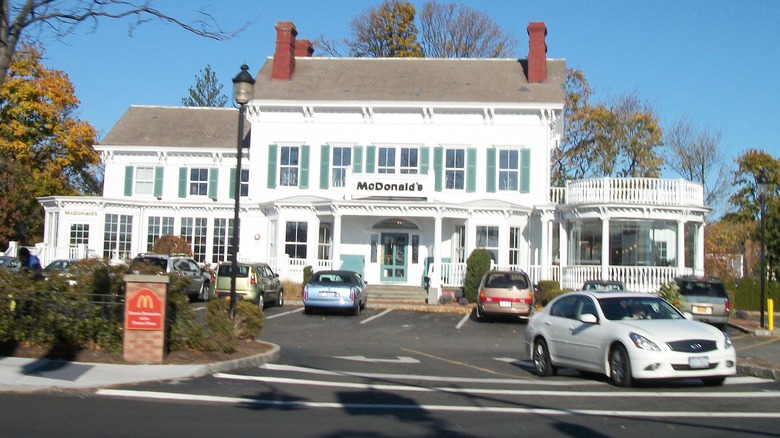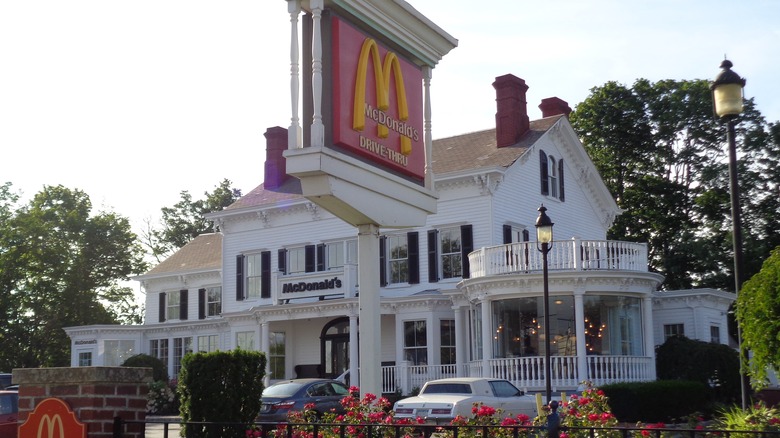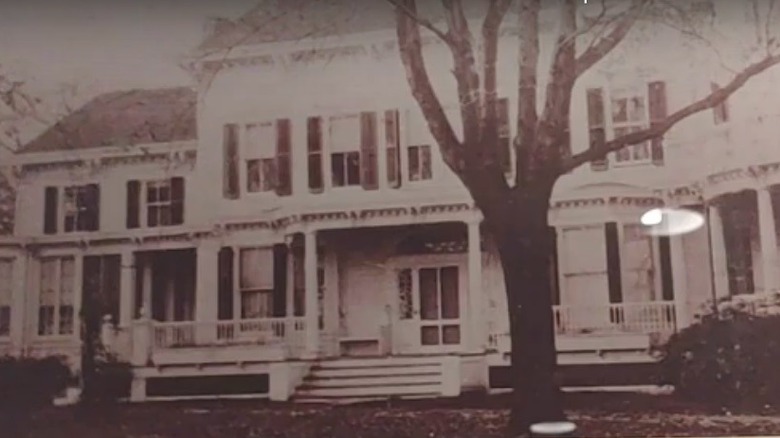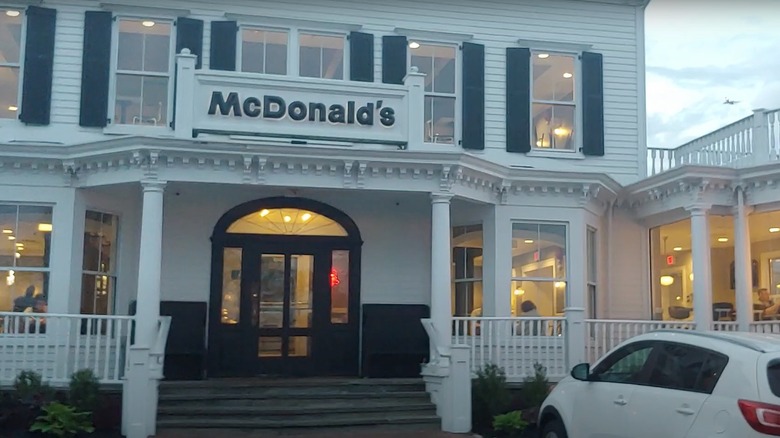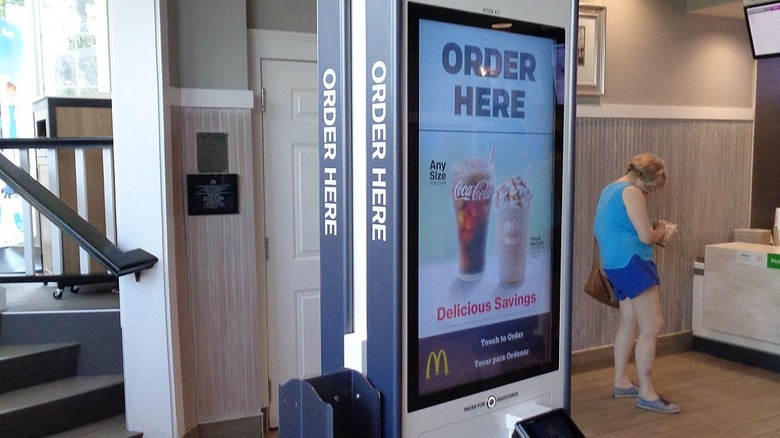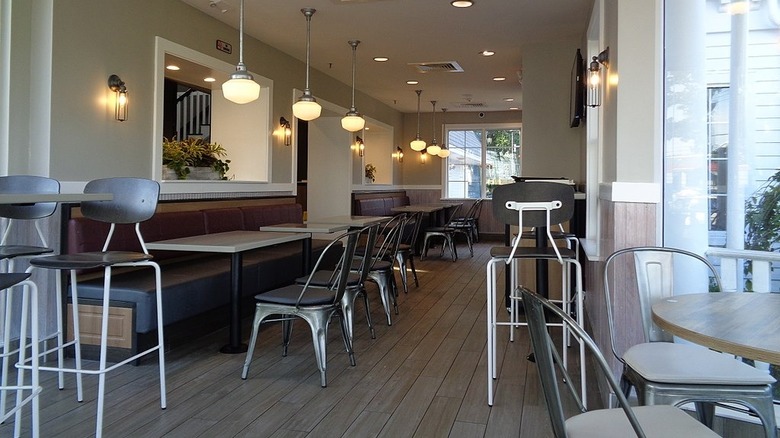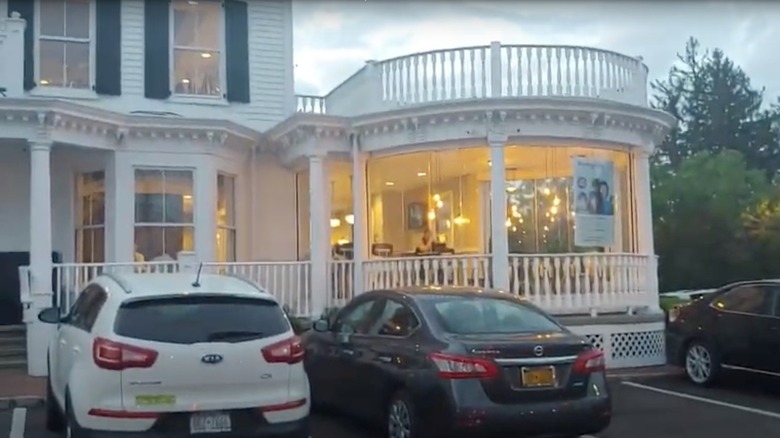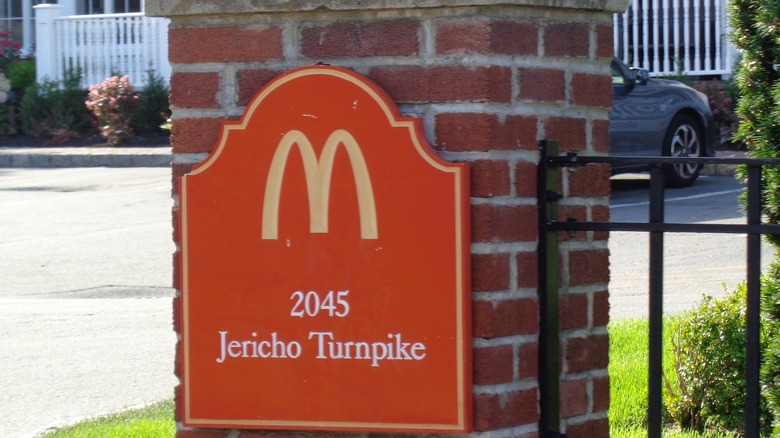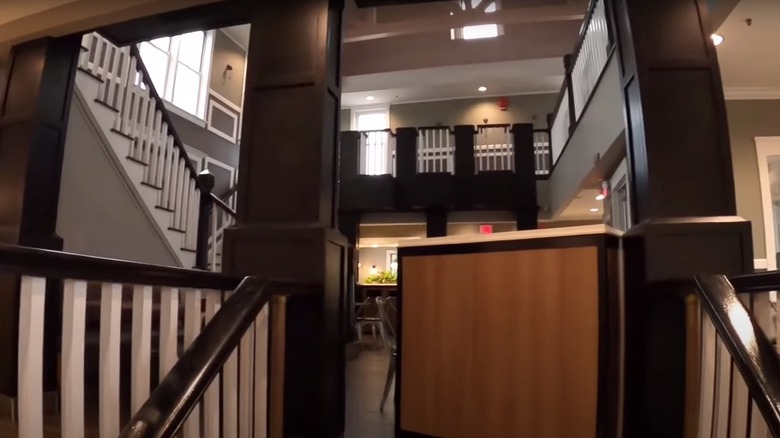The Untold Truth Of The McDonald's McMansion
In common parlance, the term "McMansion" generally refers to the ostentatiously large, cookie cutter-style suburban homes littering suburbia that, despite their size, are utterly devoid of any architectural interest. Yet within the world of fast food, the word has taken on an entirely different meaning, in that there is actually a McDonald's location within a spectacular heritage home that has come to be known as the McMansion.
As a report in the New York Post indicated, this one-of-a-kind McDonald's is situated in the Long Island community of Hempstead, New York. Diners at this unique establishment won't encounter a typical set of golden arches, but a historic Georgian mansion unlike any other McDonald's on the planet.
When this thoroughly unique McDonald's location opened for business in 1991, it was, as the Post explained, "the only franchise restaurant in the U.S. to be housed in a fully restored building." Read on to discover the untold truth of the McDonald's McMansion.
The McMansion has been dubbed the world's most beautiful McDonald's
Not only is the McMansion one beautiful McDonald's location, it has actually been described as the "world's most beautiful McDonald's" by ScoutingNY. "I practically expected a maitre d' to greet me as I went inside," wrote the post's author of the experience of stumbling upon the spectacular structure. Among the unique architectural features highlighted are "shuttered windows and brick chimneys" along with "eaves dripping with gingerbread ornamentation."
Describing the interior, ScoutingNY noted that visitors are greeted by a grand staircase in the entry foyer, leading to an additional dining area on the second level. Despite all that heritage charm, the New York Post pointed out that the restaurant underwent a "modernization initiative" in 2017 that added some new high-tech features, including "self-order kiosks, digital menu boards, and remodeled counters."
Interestingly enough, the McMansion isn't the only McDonald's to exist within a heritage building; back in 1984, reports Business Insider, the historic Gore House in Freeport, Maine, was also converted to house a McDonald's fast food eatery.
The McMansion dates back to 1795
Centuries before its current status as a purveyor of burgers and fries, the Long Island McMansion was originally constructed in the 1790s as a farmhouse. As Gothamist pointed out, in the 1860s the farmhouse was converted into a Georgian mansion; the home's owners at the time, noted the site, "were descendants of Richard Denton, a Presbyterian minister who helped to found the village of Hempstead in 1643."
In fact, reported The New York Times, the clergyman was one of the first settlers in the area. The building had originally been built by the minister's descendant Augustus Denton, who was once town supervisor for North Hempstead. Not surprisingly, the structure had come to be known as the Denton house.
"This place is gorgeous," McDonald's patron Deborah DiNoia told Newsday of the one-of-a-kind experience offered in the renovated McMansion. "We travel a lot, so we eat at McDonald's all the time and there's no McDonald's like this," she said. "It's just so homey."
The building has served many purposes before its revival as a McDonald's
According to Atlas Obscura, the home that eventually became the McMansion subsequently changed hands a number of times over the years, and wound up housing a variety of local businesses. According to Molaven Duarte's podcast, the building was used as a funeral home during the 1930s. Subsequently, the mansion became home to three different restaurants. After being purchased by the Montaruli family during this period, the family lived on the home's second floor while running Luigi's Restaurant on the main level. After the home was sold in 1955, it then housed the Charred Oak Manor, and after that, another eatery called Dallas Ribs.
As town spokesperson Dolores Sedacca told The New York Times, prior to being scooped up by McDonald's in the mid-1980s for $1 million, the historic building had been the site of ”a grand old restaurant that fell on hard times."
By that point, however, the building had been abandoned, and had fallen into a state of disrepair.
The McMansion is a designated historical landmark
When McDonald's purchased the decrepit Denton house in the 1980s, the original plan was to tear the whole thing down and construct a brand-new restaurant. "McDonald's wanted to raze the building and build a new one, but the historic society and the community fought to keep the old building," explained North Hempstead town spokesperson Dolores Sedacca to The New York Times.
Those plans, however, were kiboshed when the town's historic landmarks commission worked to confer the official designation of historic landmark on the building. This could have led to a courtroom battle between the town and the McDonald's corporation, but ultimately, Sedacca pointed out, McDonald's ”worked within the parameters” to preserve the original building and restore it to its former glory.
The experience of picking up a Big Mac or a Happy Meal for the kids, Sedacca explained, is far cry from the experience of grabbing fast food at a typical McDonald's. ”It's like going to a fine restaurant,” she said.
The place was a dump before McDonald's purchased it in 1986
When McDonald's purchased the Denton house in 1986, it had seen better days, and was far from the grandeur of even a few decades earlier.
"When we took over this building, it was a disaster, a real eyesore," McDonald's New York regional vice president said at the time, as reported by the New York Post. "There were pigeons all over. We had to gut the building, take it down to the rafters." All told, reported Molaven Duarte, the renovation project cost a hefty $4 million.
Understandably, the restoration of the building was extensive. Not only did the renovation live up to the promises made to the local heritage officials, the newly restored building itself also proved to be something of a tourist attraction. "It's like walking into a museum," customer Paul Damato explained to The New York Times shortly after the restaurant's opening in 1991. According to Damato, he actually wasn't there for a burger or Filet-O-Fish, but simply to take a look at the place. "I'm a history buff," he explained. "I wanted to see it."
The McMansion's restoration had an unanticipated side effect
Walking into the McMansion didn't just satisfy a customer's craving for junk food; the experience was also a sumptuous feast for the eyes. As one customer told The New York Times, the spectacular staircase that greets customers when they walk through the door evoked the experience of strolling into a bygone era. "Why I can just see the old days when women in long gowns walked down those staircases," Laura Joss Graff told the newspaper.
The sentiment was echoed by Larry Anderer Jr., the owner of the franchise operation housed within the McMansion. According to Anderer, he envisioned the opportunity to transform his franchise into the classiest McDonald's on the planet. "I eventually want to put tablecloths and little battery-operated candles on the tables on Friday and Saturday nights," he told the New York Times, "so young people can come here on dates."
There was, however, one unanticipated consequence of the McMansion's gorgeous interior. "The problem is our drive-through percentage is way down, because everyone wants to come in," said Paul Facella, a McDonald's regional manager who oversaw business at that particular location.
The McMansion represented a new direction for McDonald's
The fact that the McMansion looks and feels so different from a typical McDonald's is not only the result of local preservationists' efforts. It also happened to dovetail nicely with the fast-food chain's new corporate philosophy during that era, which, reported the Los Angeles Times in 1997, was reflected in its ad campaign at the time: The "My McDonald's" campaign is described as featuring "homespun commercials that imply the corporate giant is bending happily to meet local needs."
As professor Richard Francaviglia pointed out to the newspaper, by the late 1990s McDonald's had become "a much more conscientious neighbor on Main Street than it once was." This strategy in dealing with local municipalities was certainly evident in the corporate-local cooperation that ultimately led to the decrepit old Denton house becoming reimagined as the McMansion.
"The days of one standardized, one-sized McDonald's are gone," McDonald's corporate spokesman Chuck Ebeling told the Los Angeles Times. "If a local restaurant doesn't meet local needs, we're not doing what we're there to do."
The McMansion has been a venue for wedding photos
Most just-married couples, having recently walked down the aisle, probably wouldn't be making a beeline to the nearest McDonald's as the backdrop for their wedding pictures; however, the McMansion is far from a typical fast-food joint. As a result, reported the Los Angeles Times, newlyweds had been known to use the grand historical building as the posh locale for wedding photos.
This, noted the newspaper, demonstrated a new level of acceptance for the McMansion, which only came to be because of local preservationists who fought for the structure to receive its heritage designation. "It was an old house," North Hempstead spokesperson Michael Miller told the paper. "Now it's a local landmark."
In addition to preserving the town's history, the restoration of the heritage home also contributed to the overall ambience of the neighborhood. "By preserving the building, it upscaled the whole area in a way that a typical square-brick McDonald's building couldn't do," explained George Williams, chairman of the North Hempstead Landmark Preservation Commission of the added value that the McMansion brought to its environs.
The McMansion earned a restaurant review in Newsday
When the Long Island McDonald's that came to be known as the McMansion first opened in 1991, the eatery was visited by Newsday food critic Joan Reminick (she no longer writes for Newsday; her final column for the newspaper appeared in 2016 before her retirement).
In her 1991 review, recalled Insider, Reminick admitted she was bowled over by the history that pervaded the building, along with all the "dandy architectural details" on display. She cautioned readers, however, not to get their hopes up from a culinary perspective. The food served at the McMansion, she wrote, was "exactly the same" as that served at any other McDonald's she'd ever visited.
At one point in the review, she described the "potent memory-trigger" she experienced when chomping into her quarter pounder with cheese, which flooded her mind with recollections of the various times that she and her family had stopped at McDonald's for a fast meal over the years. She was hopeful that, given her McMansion experience, her next bite of a McDonald's burger would provide a different type of memory. "Perhaps my next Interstate burger will transport me to a cathedral-ceilinged room with brass sconces and period-reproduction floral wallpaper," she wrote.
